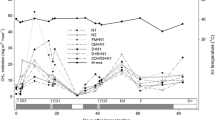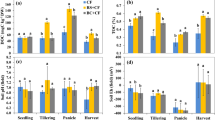Abstract
Dry-thermophilic anaerobic co-digestion (DTAD) can be used to treat forage rice straw and pig manure and generate biogas as an energy source. Solid residue produced from DTAD process can be used as a fertilizer in forage rice fields, while addition of the residue could increase methane (CH4) and nitrous oxide (N2O) emissions from the soil. We evaluated the effects of adding DTAD residue and water management on CH4 and N2O emissions from a forage rice field. Three treatments were evaluated: (a) 100 kg N · ha−1 chemical fertilizer and continuous flooding (CC); (b) residue addition (300 kg N · ha−1 DTAD residue) with continuous flooding (RC); and (c) residue addition with intermittent irrigation (RI). RC and RI showed higher CH4 fluxes than CC throughout the growing period. After a midsummer drainage, RI showed higher soil Eh values and lower CH4 fluxes (mean, 7.6 mg C · m−2 · h−1) than those in RC (mean, 18.6 mg C · m−2 · h−1). Abundance of mcrA gene copy number was not different between RC and RI, suggesting CH4 flux was reduced by suppression of methanogenic activity by intermittent irrigation. Cumulative CH4 emissions during the cultivation period were 105, 509, and 306 kg C · ha−1 in CC, RC, and RI, respectively. N2O fluxes were within detection limits in all treatments. Our results, to our knowledge, are the first to show greenhouse gas emission from forage rice fields supplemented with DTAD residue and of the effectiveness of water management in CH4 mitigation.






Similar content being viewed by others
References
Arthurson, V. (2009). Closing the global energy and nutrient cycles through application of biogas residue to agricultural land—potential benefits and drawbacks. Energies, 2(2), 226–242.
Cai, Z. C., Xing, G. X., Shen, G. Y., Xu, H., Yan, X. Y., Tsuruta, H., et al. (1999). Measurements of CH4 and N2O emissions from rice paddies in Fengqiu, China. Soil Science and Plant Nutrition, 45(1), 1–13.
Chidthaisong, A., & Watanabe, I. (1997). Methane formation and emission from flooded rice soil incorporated with 13C-labeled rice straw. Soil Biology and Biochemistry, 29(8), 1173–1181.
Conrad, R., & Klose, M. (2006). Dynamics of the methanogenic archaeal community in anoxic rice soil upon addition of straw. European Journal of Soil Science, 57(4), 476–484.
Fetzer, S., Bak, F., & Conrad, R. (1993). Sensitivity of methanogenic bacteria from paddy soil to oxygen and desiccation. FEMS Microbiology Ecology, 12(2), 107–115.
Hasebe, A., Sekiya, S., & Iimura, K. (1985). Direct determination of the differentiation process of the oxidized and reduced soil layers in paddy fields. Jarq-Japan Agricultural Research Quarterly, 19(3), 172–177.
Henckel, T., Jackel, U., & Conrad, R. (2001). Vertical distribution of the methanotrophic community after drainage of rice field soil. FEMS Microbiology Ecology, 34(3), 279–291.
Hou, A. X., Chen, G. X., Wang, Z. P., Van Cleemput, O., & Patrick, W. H. (2000). Methane and nitrous oxide emissions from a rice field in relation to soil redox and microbiological processes. Soil Science Society of America Journal, 64(6), 2180–2186.
IPCC. (2007). Climate Change 2007: The Physical Science Basis. In S. Solomon, D. Qin, M. Manning, Z. Chen, M. Marquis, K. B. Averyt, et al. (Eds.), Contribution of Working Group I to the Fourth Assessment Report of the Intergovernmental Panel on Climate Change (p. 996). United Kingdom and New York: Cambridge University Press.
Jha, A. K., Li, J., Nies, L., & Zhang, L. (2011). Research advances in dry anaerobic digestion process of solid organic wastes. African Journal of Biotechnology, 10(65), 14242–14253.
Jiao, Z. H., Hou, A. X., Shi, Y., Huang, G. H., Wang, Y. H., & Chen, X. (2006). Water management influencing methane and nitrous oxide emissions from rice field in relation to soil redox and microbial community. Communications in Soil Science and Plant Analysis, 37(13–14), 1889–1903.
Kyaw, K. M., Toyota, K., Okazaki, M., Motobayashi, T., & Tanaka, H. (2005). Nitrogen balance in a paddy field planted with whole crop rice (Oryza sativa cv. Kusahonami) during two rice-growing seasons. Biology and Fertility of Soils, 42(1), 72–82.
Le Mer, J., & Roger, P. (2001). Production, oxidation, emission and consumption of methane by soils: a review. European Journal of Soil Biology, 37(1), 25–50.
Lu, Y., Wassmann, R., Neue, H. U., Huang, C., & Bueno, C. S. (2000a). Methanogenic responses to exogenous substrates in anaerobic rice soils. Soil Biology and Biochemistry, 32(11–12), 1683–1690.
Lu, Y. H., Wassmann, R., Neue, H. U., & Huang, C. (2000b). Dynamics of dissolved organic carbon and methane emissions in a flooded rice soil. Soil Science Society of America Journal, 64(6), 2011–2017.
Ma, J., Li, X. L., Xu, H., Han, Y., Cai, Z. C., & Yagi, K. (2007). Effects of nitrogen fertiliser and wheat straw application on CH4 and N2O emissions from a paddy rice field. Australian Journal of Soil Research, 45(5), 359–367.
Ma, K., Conrad, R., & Lu, Y. (2012). Responses of methanogen mcrA genes and their transcripts to an alternate dry/wet cycle of paddy field soil. Applied and Environmental Microbiology, 78(2), 445–454.
Majumdar, D. (2003). Methane and nitrous oxide emission from irrigated rice fields: proposed mitigation strategies. Current Science, 84(10), 1317–1326.
Minamikawa, K., & Sakai, N. (2006). The practical use of water management based on soil redox potential for decreasing methane emission from a paddy field in Japan. Agriculture, Ecosystems and Environment, 116(3–4), 181–188.
Nishimura, S., Sawamoto, T., Akiyama, H., Sudo, S., & Yagi, K. (2004). Methane and nitrous oxide emissions from a paddy field with Japanese conventional water management and fertilizer application. Global Biogeochemical Cycles, 18(2), GB2017.
Patrick, W. H., & Jugsujinda, A. (1992). Sequential reduction and oxidation of inorganic nitrogen, manganese, and iron in flooded soil. Soil Science Society of America Journal, 56(4), 1071–1073.
Pramanik, P., & Kim, P. (2014). Evaluating changes in cellulolytic bacterial population to explain methane emissions from air-dried and composted manure treated rice paddy soils. Science of the Total Environment, 470(471), 1307–1312.
Riya, S., Zhou, S., Watanabe, Y., Sagehashi, M., Terada, A., & Hosomi, M. (2012). CH4 and N2O emissions from different varieties of forage rice (Oryza sativa L.) treating liquid cattle waste. Science of the Total Environment, 419, 178–186.
Sanchis, E., Ferrer, M., Torres, A. G., Cambra-López, M., & Calvet, S. (2012). Effect of water and straw management practices on methane emissions from rice fields: a review through a meta-analysis. Environmental Engineering Science, 29(12), 1053–1062.
Sasada, Y., Win, K. T., Nonaka, R., Win, A. T., Toyota, K., Motobayashi, T., et al. (2011). Methane and N2O emissions, nitrate concentrations of drainage water, and zinc and copper uptake by rice fertilized with anaerobically digested cattle or pig slurry. Biology and Fertility of Soils, 47(8), 949–956.
Singh, A., Singh, R. S., Upadhyay, S. N., Joshi, C. G., Tripathi, A. K., & Dubey, S. K. (2012). Community structure of methanogenic archaea and methane production associated with compost-treated tropical rice-field soil. FEMS Microbiology Ecology, 82(1), 118–134.
Steinberg, L. M., & Regan, J. M. (2009). mcrA-targeted real-time quantitative PCR method to examine methanogen communities. Applied and Environmental Microbiology, 75(13), 4435–4442.
Tsutsuki, K., & Ponnamperuma, F. N. (1987). Behavior of anaerobic decomposition products in submerged soils: effects of organic material amendment, soil properties, and temperature. Soil Science and Plant Nutrition, 33(1), 13–33.
Tyagi, L., Kumari, B., & Singh, S. N. (2010). Water management—a tool for methane mitigation from irrigated paddy fields. Science of the Total Environment, 408(5), 1085–1090.
US-EPA (2012) Global Anthropogenic Non-CO2 Greenhouse Gas Emissions: 1990–2030. Washington, U.S. http://www.epa.gov/climatechange/Downloads/EPAactivities/EPA_Global_NonCO2_Projections_Dec2012.pdf
Wang, Z. Y., Xu, Y. C., Li, Z., Guo, Y. X., Wassmann, R., Neue, H. U., et al. (2000). A four-year record of methane emissions from irrigated rice fields in the Beijing region of China. Nutrient Cycling in Agroecosystems, 58(1–3), 55–63.
Wassmann, R., Wang, M. X., Shangguan, X. J., Xie, X. L., Shen, R. X., Wang, Y. S., et al. (1993). First records of a field experiment on fertilizer effects on methane emission from rice fields in Hunan-province (PR China). Geophysical Research Letters, 20(19), 2071–2074.
Watanabe, A., Yoshida, M., & Kimura, M. (1998). Contribution of rice straw carbon to CH4 emission from rice paddies using 13C-enriched rice straw. Journal of Geophysical Research, [Atmospheres], 103(D7), 8237–8242.
Watanabe, A., Takeda, T., & Kimura, M. (1999). Evaluation of origins of CH4 carbon emitted from rice paddies. Journal of Geophysical Research, [Atmospheres], 104(D19), 23623–23629.
Watanabe, T., Hosen, Y., Agbisit, R., Llorca, L., Katayanagi, N., Asakawa, S., et al. (2013). Changes in community structure of methanogenic archaea brought about by water-saving practice in paddy field soil. Soil Biology and Biochemistry, 58, 235–243.
Win, K. T., Nonaka, R., Toyota, K., Motobayashi, T., & Hosomi, M. (2010). Effects of option mitigating ammonia volatilization on CH4 and N2O emissions from a paddy field fertilized with anaerobically digested cattle slurry. Biology and Fertility of Soils, 46(6), 589–595.
Yagi, K., & Minami, K. (1990). Effect of organic matter application on methane emission from some Japanese paddy fields. Soil Science and Plant Nutrition, 36(4), 599–610.
Yagi, K., Tsuruta, H., Kanda, K., & Minami, K. (1996). Effect of water management on methane emission from a Japanese rice paddy field: Automated methane monitoring. Global Biogeochemical Cycles, 10(2), 255–267.
Yuan, Q., Pump, J., & Conrad, R. (2014). Straw application in paddy soil enhances methane production also from other carbon sources. Biogeosciences, 11, 237–246.
Zheng, X., Wang, M., Wang, Y., Shen, R., Gou, J., Li, J., et al. (2000). Impacts of soil moisture on nitrous oxide emission from croplands: a case study on rice-based agro-ecosystem in Southeast China. Chemosphere Global Change Science, 2(2), 207–224.
Zhou, S., Kanai, R., Suzuki, K., Riya, S., Terada, A., & Hosomi, M. (2013). Dry-thermophilic anaerobic co-digestion of swine manure mixed with forage rice straw. In International Conference on Recent Advances in Pollution Control and Resource Recovery for the Livestock Farming Industry (RAPCP 2013), Jiaxing, China, (pp. 247–250).
Zou, J., Huang, Y., Jiang, J., Zheng, X., & Sass, R. L. (2005). A 3-year field measurement of methane and nitrous oxide emissions from rice paddies in China: Effects of water regime, crop residue, and fertilizer application. Global Biogeochemical Cycles, 19(2), GB2021.
Acknowledgments
This study was supported by an Environment Research & Technology Development Fund (B-1103) from the Ministry of the Environment, Japan. We thank two anonymous referees for their valuable comments and constructive suggestions. We are also grateful to Mr. Tamotsu Ishibashi, Kurita Water Industries LTD., for providing inoculum for dry-thermophilic anaerobic digestion.
Author information
Authors and Affiliations
Corresponding author
Rights and permissions
About this article
Cite this article
Riya, S., Katayama, M., Takahashi, E. et al. Mitigation of Greenhouse Gas Emissions by Water Management in a Forage Rice Paddy Field Supplemented with Dry-Thermophilic Anaerobic Digestion Residue. Water Air Soil Pollut 225, 2118 (2014). https://doi.org/10.1007/s11270-014-2118-3
Received:
Accepted:
Published:
DOI: https://doi.org/10.1007/s11270-014-2118-3




